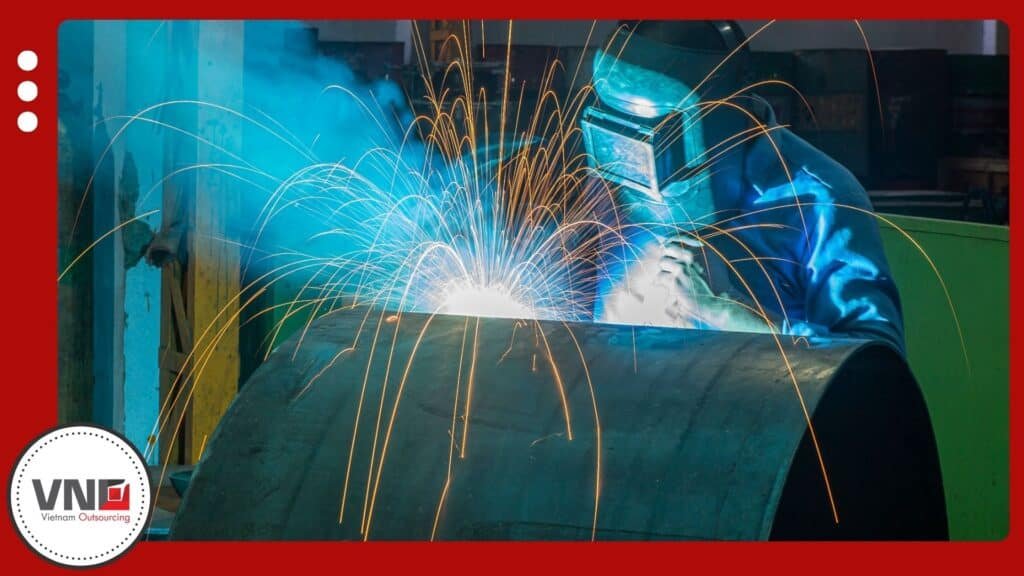Metal Fabrication Processes in Vietnam: A 2025 Guide for Buyers

Table of Contents
Introduction
As global industries continue to evolve, businesses in the U.S., Canada, UK, and EU are actively seeking high-quality yet cost-effective metal fabrication solutions. Consequently, Vietnam has emerged as a leading outsourcing destination. It offers advanced metal fabrication processes that comply with international standards while maintaining competitive pricing. This article explores key metal fabrication techniques, their advantages, and why Vietnam is the best choice for outsourcing in 2025.
Key Metal Fabrication Processes in Vietnam
CNC Metal Fabrication in Vietnam
Computer Numerical Control (CNC) machining plays a vital role in modern metal fabrication processes. Vietnamese manufacturers use CNC cutting, milling, turning, and drilling to produce precise and complex metal components with minimal errors. Because of its automation, CNC machining significantly reduces human error and improves efficiency. Additionally, it allows for faster production without compromising quality.
Advantages of CNC Metal Fabrication
- Ensures high precision and consistency
- Minimizes material waste, reducing costs
- Speeds up production cycles for faster deliveries
- Reduces labor dependency, improving efficiency
Laser Welding and Cutting for Metal Fabrication
Laser technology has transformed metal fabrication by enabling high-speed cutting, seamless welding, and improved precision. Many Vietnamese suppliers have adopted fiber and CO2 laser systems to handle various metals, including stainless steel, aluminum, and titanium. As a result, they can produce complex parts with exceptional accuracy.
Advantages of Laser Welding and Cutting
- Provides higher accuracy and cleaner cuts
- Prevents material distortion, improving final quality
- Works well for both thin and thick metal sheets
- Accelerates production times, ensuring faster fulfillment
MIG and TIG Welding in Metal Fabrication
Welding is a fundamental process in metal fabrication. In particular, MIG (Metal Inert Gas) and TIG (Tungsten Inert Gas) welding are widely used in Vietnam for automotive, aerospace, and heavy equipment manufacturing. These methods ensure strong, long-lasting connections between metal components.
Advantages of MIG and TIG Welding
- Produces strong and durable welds, ensuring reliability
- Compatible with different metals for various applications
- Cost-effective for large-scale production, lowering expenses
- Delivers high-quality finishes with minimal rework, reducing waste
Hydroforming and Deep Draw Forming in Metal Fabrication
Hydroforming is an advanced metal fabrication process where pressurized fluid shapes metal sheets into complex designs. Meanwhile, deep draw forming creates cylindrical and box-like components with minimal seams. As a result, these processes help industries achieve precision in component design while reducing material waste.
Advantages of Hydroforming and Deep Draw Forming
- Creates lightweight yet strong components, optimizing performance
- Eliminates the need for welding or secondary machining, lowering costs
- Ideal for aerospace and automotive applications requiring precision
- Reduces material usage and overall expenses, increasing efficiency
Sheet Metal Stamping and Roll Forming in Vietnam
Sheet metal stamping and roll forming are essential metal fabrication techniques for high-volume production. These methods are commonly used to manufacture brackets, panels, and enclosures. By pressing metal sheets into specific shapes using hydraulic or mechanical stamping machines, manufacturers can ensure consistency and repeatability.
Advantages of Sheet Metal Stamping and Roll Forming
- Enables high-speed production for mass manufacturing, improving efficiency
- Lowers production costs per unit, enhancing profitability
- Guarantees uniform dimensions for high-quality products
- Suitable for stainless steel, aluminum, and brass, providing flexibility
Why Vietnam is the Best Choice
Cost-Effective Metal Fabrication in Vietnam
Vietnam’s labor costs remain 40-50% lower than China’s, allowing manufacturers to offer high-quality metal fabrication services at competitive rates. Additionally, lower operational expenses and reduced overhead costs make Vietnam a cost-efficient alternative. Therefore, businesses can achieve significant savings without compromising on quality.
Advanced Manufacturing Capabilities for Metal Fabrication
With heavy investments in automation, robotics, and AI-driven quality control, Vietnam has modernized its metal fabrication industry. Today, factories operate with CNC machining, laser welding, and robotic arms to ensure efficiency and precision. As a result, companies can expect consistent and superior-quality metal components.
Strong Supply Chain and Trade Agreements Supporting Metal Fabrication
Vietnam benefits from trade agreements such as the EVFTA (EU-Vietnam Free Trade Agreement) and CPTPP (Comprehensive and Progressive Agreement for Trans-Pacific Partnership). These agreements result in lower tariffs and faster international shipping, making Vietnam a strategic choice for global businesses. Consequently, outsourcing to Vietnam provides both cost and logistical advantages.
High Compliance with International Standards
Vietnamese manufacturers adhere to ISO 9001, ASTM, and CE certifications, ensuring that metal fabrication processes meet stringent U.S. and European quality regulations. As a result, companies outsourcing to Vietnam can expect products that align with global standards. This compliance provides buyers with confidence in their sourcing decisions.
Strategic Location and Logistics Advantage for Metal Fabrication
Vietnam’s proximity to major shipping routes and its modernized ports facilitate efficient exports to North America and Europe. Major seaports such as Hai Phong, Da Nang, and Ho Chi Minh City help streamline global trade, ultimately reducing shipping lead times. This geographic advantage allows companies to maintain smooth supply chain operations.
Conclusion
Vietnam is rapidly becoming a global hub for advanced metal fabrication processes. It offers cost savings, modern technologies, and high-quality standards. For businesses in the U.S., Canada, UK, and the EU, outsourcing to Vietnam provides a scalable and cost-effective alternative to traditional suppliers in China and India. Furthermore, with strong trade agreements, expanding infrastructure, and an increasingly skilled workforce, Vietnam stands out as the best choice for metal fabrication outsourcing in 2025.

